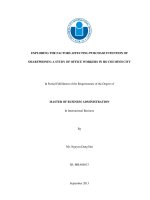factor influencing purchase intention of electric vehicles of fpt student
Bạn đang xem bản rút gọn của tài liệu. Xem và tải ngay bản đầy đủ của tài liệu tại đây (1.2 MB, 32 trang )
<span class="text_page_counter">Trang 1</span><div class="page_container" data-page="1">
<b>INTRODUCING THE RESEARCH TOPIC:</b>
<b>Factor influencing purchaseintention of electric vehicles of</b>
<b>FPT student </b>
<b>(Group assignment 3) </b>(Fall 2023)
<i>Members of group: </i>
Trần Thị Huyền Anh - HA150107Phạm Quỳnh Anh - HS150671Trương Thị Khanh - HS150606Nguyễn Thành Nam - HE150399Nguyễn Lê Trang Linh - HS150394
</div><span class="text_page_counter">Trang 2</span><div class="page_container" data-page="2">1.5. Structure of your research paper...
<b>II. LITERATURE REVIEW...</b>
2.6. Proposed Research Model...
<b>III. RESEARCH METHODOLOGY...</b>
1. Research design...
2. Survey form...
3. Survey distribution...
<b>IV. RESULTS AND DISCUSSION...</b>
1. Participants overview and sample size...
2. Pearson Correlation Analysis...
</div><span class="text_page_counter">Trang 3</span><div class="page_container" data-page="3">Currently, the global electric vehicle industry is extremely developing, contributing significantly to economic growth. Therefore, it is important to understand and grasp the factors that influence consumers' intention to use electric vehicles, with Vietnam being one ofthe countries with electric vehicle manufacturing companies. And this study explores the factors that influence consumers' intention to buy electric vehicles in Vietnam. The quantitative research was surveyed by questionnaire to all students of FPT University Hanoi, obtaining 105 valid responses, conducted from October 30 to November 4, 2023. The study focused on financial factors, environmental concerns, performance expectations, convenienceand demographic influences with Descriptive Statistics and Inferential Statistics techniques. The results show that environmental concerns, financial incentives, favourable conditions, and social influence have a positive impact while price has a negative impact on consumers' intention to buy electric vehicles. Ultimately, this research on consumer behaviour is important because it can inform the development of appropriate policies and strategies for theelectric vehicle industry.
The rate of urbanisation in our nation is currently at 3% per year, and individuals arebeginning to see the need of prioritising a better personal life. Our nation is attempting tocreate smart cities using cutting-edge technology. In addition to meeting these smart cityrequirements, "green lifestyle" advertising efforts are intensifying and educating people aboutenvironmental protection vehicles. (1)
According to a survey conducted by the Vietnam Association of MotorcycleManufacturers (VAMM), approximately 500,000 electric motorbikes and electric bicycleswere sold in Vietnam overall in 2017, a 30% increase from the previous year. Growth rate in2018 was around 40%. The introduction of the VinFast Klara electric vehicle at the tail endof 2018 had a significant impact on the Vietnamese market for electric motorbikes. Over 3million electric bicycles and electric motorcycles are currently in use nationwide, accordingto the most recent statistics from the Market Management Department (Ministry of Industryand Trade). Vietnamese consumers use between 250,000 and 300,000 electric automobilesannually.
Users under the age of 18 make up 8% of users, while users between the ages of 18 and22 make up the majority (80.4%). Most high school, high school, university, and collegestudents use electric bicycles. The usage percentage is incredibly low (1%), especially among
</div><span class="text_page_counter">Trang 4</span><div class="page_container" data-page="4">the elderly and retired. 90% of electric bicycle users are students, with office workers,workers, and housewives following closely behind (3% each). (2)
Students are the group of people that utilise electric vehicles the most, as the reportmentioned above demonstrates. My team's research focused on the elements influencing FPTstudents' intention to buy electric automobiles in order to determine whether this finding isfavourable or not.
1.2. Research objectives
<b>QUỲNH ANH</b>
- Outline the factors that influence FPT students' intention to use electric vehicles. - Evaluate the level of factors affecting FPT students' intention to purchase electric vehicles. - Provide some solutions to overcome factors to promote car purchasing by FPT students
1.3. Research question
<b>HUYỀN ANH</b>
● Research questions about FPT student demographics
For example: Age, gender, income, degree status, ever owned an electric vehicle,...● The research question aims to find out the factors that determine FPT students' use of
electric vehicles
<i>- What factors affect students' needs and willingness to use electricity?</i>
(factors such as awareness of the benefits and risks of electric vehicles, the cost of owning an electric vehicle, and the ease and convenience of electric vehicles compared to other vehicles.)
<i>- What factors affect student satisfaction and loyalty to electric vehicles?</i>
(factors such as the quality and performance of the electric vehicle, the price and maintenancecosts of the electric vehicle, the warranty service of the electric vehicle supplier, the safety and security of the electric vehicle, the variety and variety of electric vehicle models, environmental and social friendliness of electric vehicles, infrastructure and support equipment for electric vehicles, regulations and policies related to electric vehicles.)
1.4. Research contributions
Researching the intention to purchase electric vehicles of university students can be conducted with the aim of understanding and analysing the impact of factors on the decision to purchase electric vehicles of this group of young people.
Theoretical side:
● Researching the intention to buy electric cars of FPT university students can provide information about consumer behaviour and analyse factors affecting the intention to buy electric cars, including price, convenience, environmental awareness. school and other factors.
Practical side :
● Policy orientation: The results of this study can provide important information for government managers and related organisations in guiding policies and strategies for electric vehicle development. A better understanding of FPT university students' intention to purchase electric vehicles can help identify incentives and support
</div><span class="text_page_counter">Trang 5</span><div class="page_container" data-page="5">measures, as well as develop appropriate policies to promote the use of electric vehicles among the population. this consumption.
● Marketing and product development: This research can assist electric vehicle manufacturers in better understanding the needs and expectations of FPT university students regarding electric vehicles. Research results can play an important role in the design, development and marketing of electric vehicle products, from creating attractive features and amenities to identifying market segments and suitable marketing strategy.
● Encouraging the use of electric vehicles: Researching the intention to buy electric vehicles of FPT university students can contribute to promoting the conversion to using electric vehicles. The research results can help government agencies and NGOs identify incentives, supports and discounts to create attractiveness and promote the use of electric vehicles in the living community of university students.
1.5. Structure of your research paper
<b>HUYỀN ANH</b>
Study’s structure:
Abstract I. Introduction II. Literature review III. Research method IV. Results
V. Reliability and validity of the research VI. Conclusion
<b>II. LITERATURE REVIEW</b>
1 Literature review
<b>QUỲNH ANH(5) + NAM(5)</b>
imply if the hyis accepted or r
www.mdpi.com/2071-Factors influencing thepurchase of electric vehicles in China
1. Theory of Planned Behavior
2. Technology Acceptance Model3. Innovation Diffusion Theory
Hypothesis 1. Consumers’ attoward electricvehicles has a significantly pimpact on theirpurchase intenHypothesis 2. Consumers’ sunorm regardingvehicles has a
</div><span class="text_page_counter">Trang 6</span><div class="page_container" data-page="6">significantly pimpact on theirpurchase intenHypothesis 3. Consumers’ secontrol ability regarding electvehicles has a significantly pimpact on theirpurchase intenHypothesis 4. Consumers’ peusefulness of evehicles has a significantly pimpact on theirtoward behavioHypothesis 5. Consumers’ peease of use of vehicles has a significantly pimpact on theirtoward behavioHypothesis 6. Consumers’ compatibility regarding electvehicles has a significantly pimpact on theirtoward behavioHypothesis 7. Consumers’ peinnovativenessregarding electvehicles has a significantly pimpact on theirtoward behavioHypothesis 8. Interpersonal ihas a significanpositive impacconsumers’ sub
</div><span class="text_page_counter">Trang 7</span><div class="page_container" data-page="7">norm.Hypothesis 9. influence has asignificantly pimpact on conssubjective norm
Factors on consumer’s intention towards purchasing hybrid cars from Arab Buyers
1. Problem recognition2.Information search3.Alternatives Evaluation4.Purchase Decision5.Post-purchase Behaviour
H1: Price has positively imptowards buyerspurchase intenelectric cars.H2: Reputationpositively imptowards buyerspurchase intenelectric cars.H3: Brand Imapositively imptowards buyerspurchase intenelectric cars.H4: Fuel Econpositively imptowards buyerspurchase intenelectric cars.H5: Safety Ratpositively imptowards buyerspurchase intenelectric cars.
purchase intention towards E-vehicles among thePotential Indian consumers
1.Review of Theoretical Framework2.Purchase intention inthe context of Utility Theory
3.Theory of Planned Behavior
4.Technology Acceptance Model (TAM)
H1 Awarenestowards EVs acontribution toenvironment hsignificant posrelationship wipurchase intenEVsH2 Performanfeatures have asignificant andrelationship wipurchase inten
</div><span class="text_page_counter">Trang 8</span><div class="page_container" data-page="8">EVsH3 Financial fhave a significpositive relatiowith purchase intension for EH4 The ecosysupport positivinfluence the pintension for EH5 Pro-envirobehavior has asignificant posrelationship wipurchase intenfor EVsH6 Concern toenvironment mthe relation betperformance anpurchaseintention for EH7 Concern toenvironment mthe relation betproduct awarenpurchase intenEVs
Purchase Intention of Electric
Vehicles: Empirical evidence from Vietnam
Consumption value theory
Rational choice theoryTheory of planned behaviour
H1 The willingpay is positiverelated to the inof consumers tpurchase EVsH2a The resistchange is positrelated to the willingness to consumers for H2b Resistancchange is positrelated to the inof consumers tpurchase EVs.H3a Need for uniqueness is positively relat
</div><span class="text_page_counter">Trang 9</span><div class="page_container" data-page="9">the willingnessof consumers fH3b Need for uniqueness is positively relatthe intention oconsumers to pEVs.H4a The environmentalof consumers ipositively relattheir willingnemore for EVs.H4b The environmentalof consumers ipositively relattheir intention purchase EVs.H5a The percetrust in EVs ofconsumers is prelated to theirwillingness to EVs.H5b The percetrust in EVs ofconsumers is prelated to theirintention to puEVs.H6 The personnorms are posirelated to the inof consumers tpurchase EVs.H7a The percevalue is positivrelated to the willingness to consumers for H7b The percevalue is positivrelated to the inof consumers t
</div><span class="text_page_counter">Trang 10</span><div class="page_container" data-page="10">purchase EVs.
www.mdpi.com/2071-Electric vehicle purchase intention of the public in Pakistan
Theory of reasoned action
Standard activation theory
Theory of planned behaviourUnified theory
Hypothesis 1 (Environmentalconcerns positaffect individubehavioral inteto purchase EVHypothesis 2 (Performance expectancy (PEpositively affeindividuals’ beintentions to puEVs.Hypothesis 3 (Effort expectanpositively affeindividuals’ beintentions to puEVs.Hypothesis 4 (Facilitating con(FC) positivelyindividuals’ beintentions to puEVs.Hypothesis 5 (Social influencpositively affeindividuals’ beintentions to puEVs.
Find implications for revitalising the spread of electric vehicles by analysing important factors in purchasing electric vehicles for consumers who actually operate electric vehicles.
- Theory of Planned Behavior – TPB
H1: The imporvalues of electvehicle purchafactors will vargender. H2: The imporvalues of electvehicle purchafactors will vardepending on a H3: The impovalues of electvehicle purcha
</div><span class="text_page_counter">Trang 11</span><div class="page_container" data-page="11">factors will vardepending on tincome level. H4: The imporvalues of electvehicle purchafactors will vardepending on tdegree of impoof performance
Identify factors that positively and negatively affect the use of electric motorbikes based on measurement standardsand recommendations and solutions proposedby the Government and businesses to develop the electric motorbike market in Vietnam.
Technology acceptance model (TAM)
H1: Perceived usefulness posaffects users' aof EMs. H2: Perceived use positively users' adoptionEMs.H3: Perceived use positively perceived usefH4: Perceived negatively affeusers' adoptionEMs.
(EMs: Electricmotorbikes)
www.mdpi.com/2071-Analyse the psychological factors with the situational factors that impact the consumer acceptance of full electric vehicles, and test the relationships among these factors.
-Confirmatory factor analysis (CFA)-The structural equation modelling (SEM)r
<i>-H1.A user’s </i>
<i>environmentalhas a positive on the user’s perception of environmental</i>
<i>H2. A user’s </i>
<i>environmentalhas a positive on the user’s perception of economic bene</i>
</div><span class="text_page_counter">Trang 12</span><div class="page_container" data-page="12"><i>H3.A user’s </i>
<i>environmentalhas a positive on the user’s perception of felectric vehicle</i>
<i>H4. A user’s </i>
<i>environmentalhas a positive on the user’s behavioural intowards full elvehicles.</i>
<i>H5. A user’s </i>
<i>perception of environmentalhas a positive on the user’s perception of economic bene</i>
<i>H6: A user’s </i>
<i>perception of environmentalhas a positive on the user’s perception of felectric vehicle</i>
<i>H7. A user’s </i>
<i>perception of economic benepositive impacuser’s perceptifull electric veh</i>
<i>H8. A user’s </i>
<i>perception of economic benepositive impacuser’s behaviointention towaelectric vehicle</i>
<i>H9.A user’s </i>
<i>perception of felectric vehiclepositive impacuser’s behaviointention towa</i>
</div><span class="text_page_counter">Trang 13</span><div class="page_container" data-page="13">9 https://
www.mdpi.com/2032-i) to identify the factors influencing the adoption of electric vehicles in India. (ii) to investigate the demographic factors influencing electric vehicle adoption.
-Confirmatory Factor Analysis- CFAStructural Equation Modelling- SEM
Hypothesis 1 (There is a signassociation betfinancial incenelectric vehicleadoption. Hypothesis 2 (
<i>There is a signassociation becharging infrastructure electric vehicleadoption.</i>
Hypothesis 3 (
<i>There is a signassociation besocial reinforcand electric veadoption.</i>
Hypothesis 4
<i>(H4):There is </i>
<i>significant assbetween environmentaland electric veadoption.</i>
Hypothesis 5 (
<i>There is a signassociation beprice and electvehicle adoptio</i>
that influence the intention to use electricvehicles in Malaysia
Theory of Planned Behavior (TPB)
Hypothesis 1 (H1):There is astatistical signirelationship anbetween EnvironmentalConcern (EC) Usage IntentioHypothesis 2 (H2):There is astatistical signi
</div><span class="text_page_counter">Trang 14</span><div class="page_container" data-page="14">relationship anbetween ConsuKnowledge (CUsage IntentioHypothesis 3 (There is a statisignificant relaand impact betPsychological (PB) and UsagIntention (INTHypothesis 4 (H4):There is astatistical signirelationship anbetween InfrasReadiness (IR)Usage IntentioHypothesis 5 (H5):There is astatistical signirelationship anbetween Demo(DG) and UsagIntention (INT
</div><span class="text_page_counter">Trang 15</span><div class="page_container" data-page="15">adopt electric vehicles in the study. In contrast, Degirmenci and Breitner (Kenan Degirmenci a et al., 2017) (5)suggest that EC is a stronger predictor of attitude toward electric vehicle purchase intention than price value and reliability within range. From the studies mentioned above, it is clear that EC is an important factor affecting the public's intention to purchase electric vehicles. Because of this, we propose the following hypothesis.
Hypothesis 1: Consumers' environmental concerns are positively related to their electric vehicle purchase intention.
<i>2.2. Financial incentives(FI)</i>
Financial incentives are the promotion and support of positive financial activities within an individual, organisation or financial system. The goal of financial incentives is to create a favourable environment for people and organisations to participate in financial activities through the provision of information, education and support tools.
Government policy has a significant impact on electric vehicle adoption. By formulating customer-friendly policies and providing financial incentives for production and consumption, the government stimulates product usage. In Vietnam, the Ministry of Finance has also issued a draft Decree halving registration fees for electric vehicles (VinFast, 2022)(6)
Customers are motivated to buy electric vehicles due to the availability of financial incentives. Many studies have confirmed that electric vehicle adoption is a result of government financial incentives. The Indian government has accelerated the adoption and production of hybrid and electric vehicles (FAME) in the country. To increase electric vehicle adoption in India, the government has introduced both financial and non-financial incentives. Financial incentives are an important factor in determining electric vehicle adoption. Financial incentives come in various forms (Siddiqui et al., 1970)(7)
In addition, electric vehicles are also environmentally friendly and contribute to environmental protection. Therefore, the government offers financial incentives to encourage rapid adoption of electric vehicles to conserve resources and protect the environment (Ning Wang et al., 2018)(8). Therefore, it is believed that financial incentives are indirect drivers that play an important role in electric vehicle adoption. The following hypothesis can be stated.
Hypothesis 2: Financial incentives positively influence electric vehicle purchasing behaviour.
<i>2.3. Price(P)</i>
Price is the quantity of one thing that is exchanged or demanded in exchange or sold for another thing. Price can also be defined as the value or amount expected to be paid in exchange for a product or service.
The price of electric vehicles is considered to be the main factor negatively influencing consumers to purchase electric vehicles because the higher cost of Li-ion batteries today forces potential buyers to shy away from the purchase decision. The high purchase price of electric vehicles is considered a major limitation in many consumer survey studies (Sanya Carley a et al., 2012 ; Zhen-Yu She et al., 2017)(9)(10). The technology used
</div><span class="text_page_counter">Trang 16</span><div class="page_container" data-page="16">in the production of electric vehicles is expensive and this will increase the value of the vehicle (Lance Noel PhD a b et al., 2020)(11). As continued efforts are made and newer technologies are introduced to increase the range of electric vehicles, the complexity of the battery materials (Lithium-ion batteries) used will increase (Mehmet Efe Biresselioglu a et al., 2018)(12). Therefore, replacing such batteries in the future will be very expensive. Poor understanding of fuel costs and vehicle maintenance also contributes to this barrier.Hypothesis 3: Price has a negative impact on customers' intention to purchase electric vehicles.
<i>2.4. Facilitating conditions (FC)</i>
<b>TRANG LINH</b>
Facilitating conditions (FC) means the degree to which an individual believes that the organisational and technical infrastructure is in place to support the use of the system. In the context of electric vehicles, enabling conditions refer to the future availability of institutions and infrastructure necessary for the smooth use of electric vehicles for daily commuting activities.
Charging infrastructure:
Charging infrastructure is important for electric vehicle owners. Customers are more confident when buying electric vehicles thanks to charging infrastructure (Adedamola Adepetu a et al., 2015) (13). Every customer does not have the ability to install charging infrastructure at their home. Therefore, improving public charging infrastructure for electric vehicles is important. Unlike traditional vehicles that often only refuel at gas stations, electricvehicles can recharge at many locations in many ways such as home, work, public places and on the highway for long distance trips (Engel et al., 2018) (14). Cities with high land prices and larger populations need robust charging infrastructure. Deploying public charging infrastructure in anticipation of growth in electric vehicle sales is critical for widespread adoption of electric vehicles. For example, in Norway, there were approximately 1.3 light battery electric vehicles per public charging point in 2011, which has supported continued adoption (Iea) (15). When customers consider purchasing an electric vehicle, they consider charging infrastructure, charging point interoperability, and charging station availability (Scott Hardman et al., 2018) (16). For example, in rural municipalities, public charging pointsshould be located mainly along roads with heavy traffic to reduce distance anxiety. Charging infrastructure has begun to have a positive relationship with electric vehicle adoption. Therefore, good charging infrastructure plays a huge role in consumer adoption of electric vehicles.
Presence of electric vehicle repair shops:
The presence of repair shops equipped to service electric vehicles can also influence consumers' decisions to purchase electric vehicles. A large number of independent repair shops have begun servicing battery electric vehicles (BEVs) and hybrid electric vehicles (HEVs). On average, for every 100 vehicles maintained, 3-4 are BEVs and about 6% are HEVs (Staff, 2021) (17). Many repair shops have invested in tools, equipment, and training of their technicians to service BEVs and HEVs (Bill, 2022) (18). This investment not only equips stores to solve specific problems related to electric vehicles, but also signals to potential buyers that post-purchase maintenance and servicing will not be a problem.
However, it is important to note that the impact of favourable conditions on electric vehicle adoption may vary depending on the specific context and region. For example, one
</div>








